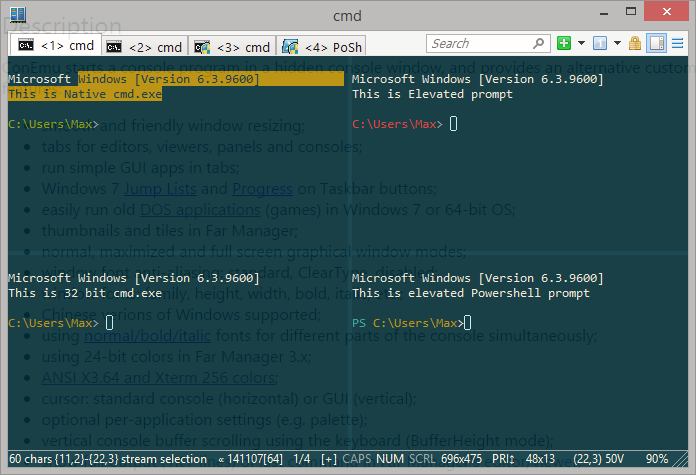[ChatScript] ChatScript - https://github.com/bwilcox-1234/ChatScript
Natural Language tool/dialog manager
ChatScript
Natural Language tool/dialog manager
ChatScript is the next generation chatbot engine that has won the Loebner's 4 times and is the basis for natural language company for a variety of tech startups.
ChatScript is a rule-based engine, where rules are created by humans writers in program scripts through a process called dialog flow scripting. These use a scripting metalanguage (simply called a "script") as their source code. Here what a ChatScript script file looks like:
#
# file: food.top
#
topic: ~food []
#! I like spinach
s: ( I like spinach ) Are you a fan of the Popeye cartoons?
a: ( ~yes ) I used to watch him as a child. Did you lust after Olive Oyl?
b: ( ~no ) Me neither. She was too skinny.
b: ( yes ) You probably like skinny models.
a: ( ~no ) What cartoons do you watch?
b: ( none ) You lead a deprived life.
b: ( Mickey Mouse ) The Disney icon.
#! I often eat chicken
u: ( ![ not never rarely ] I * ~ingest * ~meat ) You eat meat.
#! I really love chicken
u: ( !~negativeWords I * ~like * ~meat ) You like meat.
#! do you eat bacon?
?: ( do you eat _ [ ham eggs bacon] ) I eat '_0
#! do you like eggs or sushi?
?: ( do you like _* or _* ) I don't like '_0 so I guess that means I prefer '_1.
#! I adore kiwi.
s: ( ~like ~fruit ![~animal _bear] ) Vegan, you too...
#! do you eat steak?
?: ( do you eat _~meat ) No, I hate _0.
#! I eat fish.
s: ( I eat _*1 > )
$food = '_0
I eat oysters.
Above example mentioned in article How to build your first chatbot using ChatScript.
Basic Features
- Powerful pattern matching aimed at detecting meaning.
- Simple rule layout combined with C-style general scripting.
- Built-in WordNet dictionary for ontology and spell-checking.
- Extensive extensible ontology of nouns, verbs, adjectives, adverbs.
- Data as fact triples enables inferencing and supports JSON representation.
- Rules can examine and alter engine and script behavior.
- Planner capabilities allow a bot to act in real/virtual worlds.
- Remembers user interactions across conversations.
- Document mode allows you to scan documents for content.
- Ability to control local machines via popen/tcpopen/jsonopen.
- Ability to read structured JSON data from websites.
- Postgres and Mongo databases support for big data or large-user-volume chatbots.
OS Features
- Runs on Windows or Linux or Mac or iOS or Android
- Fast server performance supports a thousand simultaneous users.
- Multiple bots can cohabit on the same server.
Support Features
- Mature technology in use by various parties around the world.
- Integrated tools to support maintaining and testing large systems.
- UTF8 support allows scripts written in any language
- User support forum on chatbots.org
- Issues or bugs on this repo
Getting started
Installation
Take this project and put it into some directory on your machine (typically we call the directory ChatScript, but you can name it whatever). That takes care of installation.
git clone https://github.com/bwilcox-1234/ChatScript
Standalone mode - run locally on a console (for developement/test)
From your ChatScript home directory, go to the BINARIES directory:
cd BINARIESAnd run the ChatScript engine
Windows
ChatScriptLinux
./LinuxChatScript64 localNote: to set the file executable: chmod a+x ./LinuxChatScript64
MacOS
./MacChatScript localThis will cause ChatScript to load and ask you for a username. Enter whatever you want. You are then talking to the default demo bot Harry.
Server Mode (for production)
From your ChatScript home directory, go to the BINARIES directory and run the ChatScript engine as server
Run the server on Windows
ChatScript port=1024Run the server on Linux
./LinuxChatScript64Run the server on MacOS
./MacChatScriptThis will cause ChatScript to load as a server.
But you also need a client (to test client-server communication). You can run a separate command window and go to the BINARIES directory and type
Run a client (test) on Windows
ChatScript client=localhost:1024 Run a client (test) on Linux
./LinuxChatScript64 client=localhost:1024Run a client (test) on MacOS
./MacChatScript client=localhost:1024This will cause ChatScript to load as a client and you can talk to the server.
How to build a bot
Run ChatScript locally. From the ChatScript command prompt, type
:build Harry
or whatever other preinstalled bot exists. If you have revised basic data, you can first:
:build 0
How to compile the engine.
On windows if you have Visual Studio installed, launch VS2010/chatscript.sln or VS2015/chatscript.sln and do a build. The result will go in the BINARIES directory.
On Linux, go stand in the SRC directory and type make server (assuming you have make and g++ installed). This creates BINARIES/ChatScript, which can run as a server or locally. There are other make choices for installing PostGres or Mongo.
Full Documentation
ChatScript Wiki (user guides, tutorials, papers)
Contributing
- Fork it
- Create your feature branch (git checkout -b my-new-feature)
- Commit your changes (git commit -am 'Add some feature')
- Push to the branch (git push origin my-new-feature)
- Create new Pull Request
Last releases
Author
- Bruce Wilcox
- home website: BrilligUnderstanding.com
- mail: gowilcox@gmail.com
'프로그래밍 > AI_DeepLearning' 카테고리의 다른 글
| 랜덤 포레스트 (0) | 2017.07.26 |
|---|---|
| [ChatScript] ChatScript 에서 Harry를 Dorothy로 바꾸고, 한글인사하기 (0) | 2017.07.26 |
| [ChatScript] ChatScript start & stop (0) | 2017.07.25 |
| [ChatScript] ChatScript 를 Mac에 설치하기. (0) | 2017.07.24 |
| 두바이 거리 순찰, 자율주행차가 맡는다 OTSAW Robotics O-R3. (0) | 2017.07.05 |



